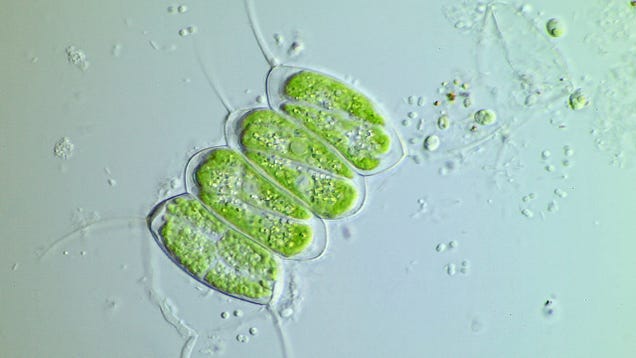Scientists Discover a Virus That Makes Humans Less Intelligent
algae includes more than 7,000 water-dwelling organisms that resemble plants but belong to a separate biological kingdom. They're typically found in aquatic environments like ponds, lakes, and oceans.
Prior to the new study, which now appears in PNAS, scientists did not know the Chlorovirus was capable of infecting humans. The scientists accidentally stumbled upon the algae virus while analyzing the microbial population of the throats of healthy people for a non-related study. These samples were obtained from participants who were participating in research that included measures of cognitive functioning.
Analysis revealed that 40 of 92 participants (43.4%) in the study tested positive for the algae viruses. That's a disturbingly high number — a discovery that suggests millions might be carrying the long-lasting infection (though, at <100 participants, these results clearly need to be reproduced elsewhere before we can make more definitive proclamations). The researchers aren't entirely sure how it comes to infect humans, but they did show that infections are not exclusive to swimmers.
A press release from John Hopkins Medicine explains its effect on cognitive functioning:
The group that harbored the virus performed worse overall on a set of tasks to measure the speed and accuracy of visual processing. While their performance was not drastically poorer, it was measurably lower, the researchers say. For example, people who harbored the virus scored, on average, nearly nine points lower on a test that measured how quickly they could draw a line between sequentially numbered circles on a piece of paper. Viral carriers also scored seven points lower, on average, on tests measuring attention.To further elucidate the effects of the virus, the investigators infected a group of mice and analyzed their performance on a set of tests designed to measure the rodent equivalent of human cognitive function. Animals infected with the virus exhibited deficits similar to those observed in humans. Infected animals had worse recognition memory and spatial orientation than uninfected mice. For example, they had a harder time finding their way around a maze, failing to recognize a new entry that was previously inaccessible. In addition, infected animals were less likely to pay attention to a new object, spending nearly 30 percent less time exploring it than uninfected mice, a finding that suggest shorter attention span and greater distractibility. The researchers caution that drawing direct links between mice and humans can be reductive but, they say, the parallels observed in the study were rather striking......Analysis of brain samples from virus-infected mice revealed changes in the expression of multiple genes found in the hippocampus, the part of the brain that sorts and catalogues short-term and long-term memories and guides spatial orientation. Some of these alterations involved genes that regulate brain response to dopamine — a neurotransmitter affecting a wide range of neurologic and cognitive functions — as well as genes involved in immune cell regulation. The finding of multiple gene involvement suggests numeous mechanisms that may explain some of the effects observed in the study, the researchers say. The investigators, however, caution that their findings require in-depth follow-up to clarify the effects of the virus on human cognition and the exact mechanisms that precipitate them.
Thankfully, the cognitive impacts are slight, but it's a disturbing discovery nonetheless. Not only does the new study reveal a new class of viruses capable of infecting humans, it shows that certain microorganisms can trigger subtle physiological changes without causing full-blown disease.
Read the entire study at PNAS: "Chlorovirus ATCV-1 is part of the human oropharyngeal virome and is associated with changes in cognitive functions in humans and mice".
.png)



0 კომენტარი: